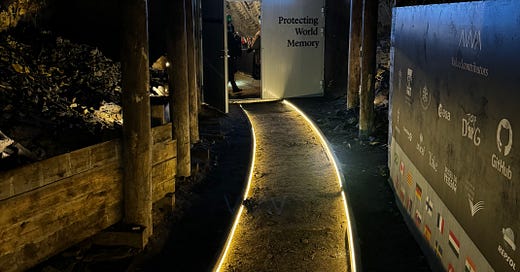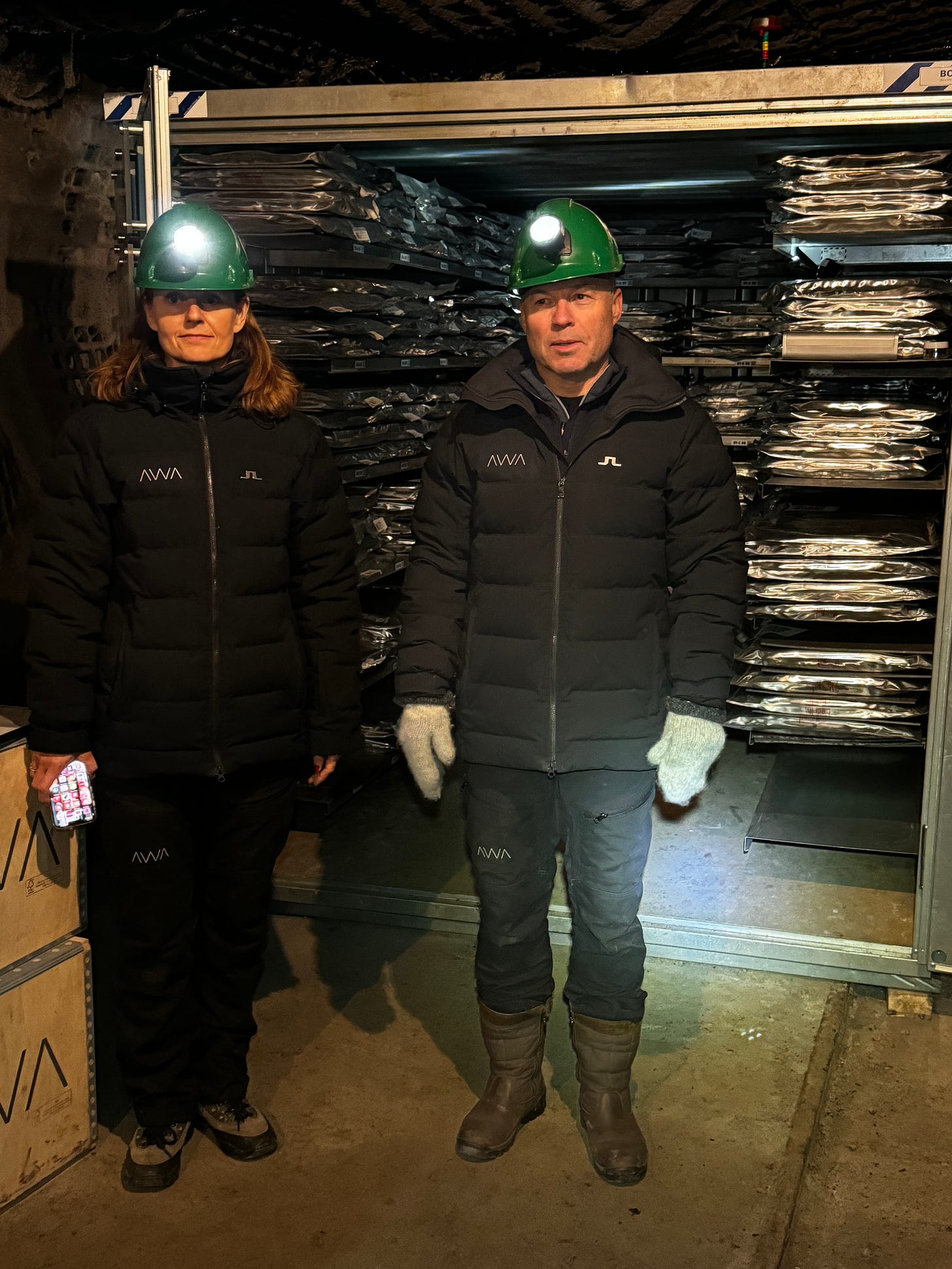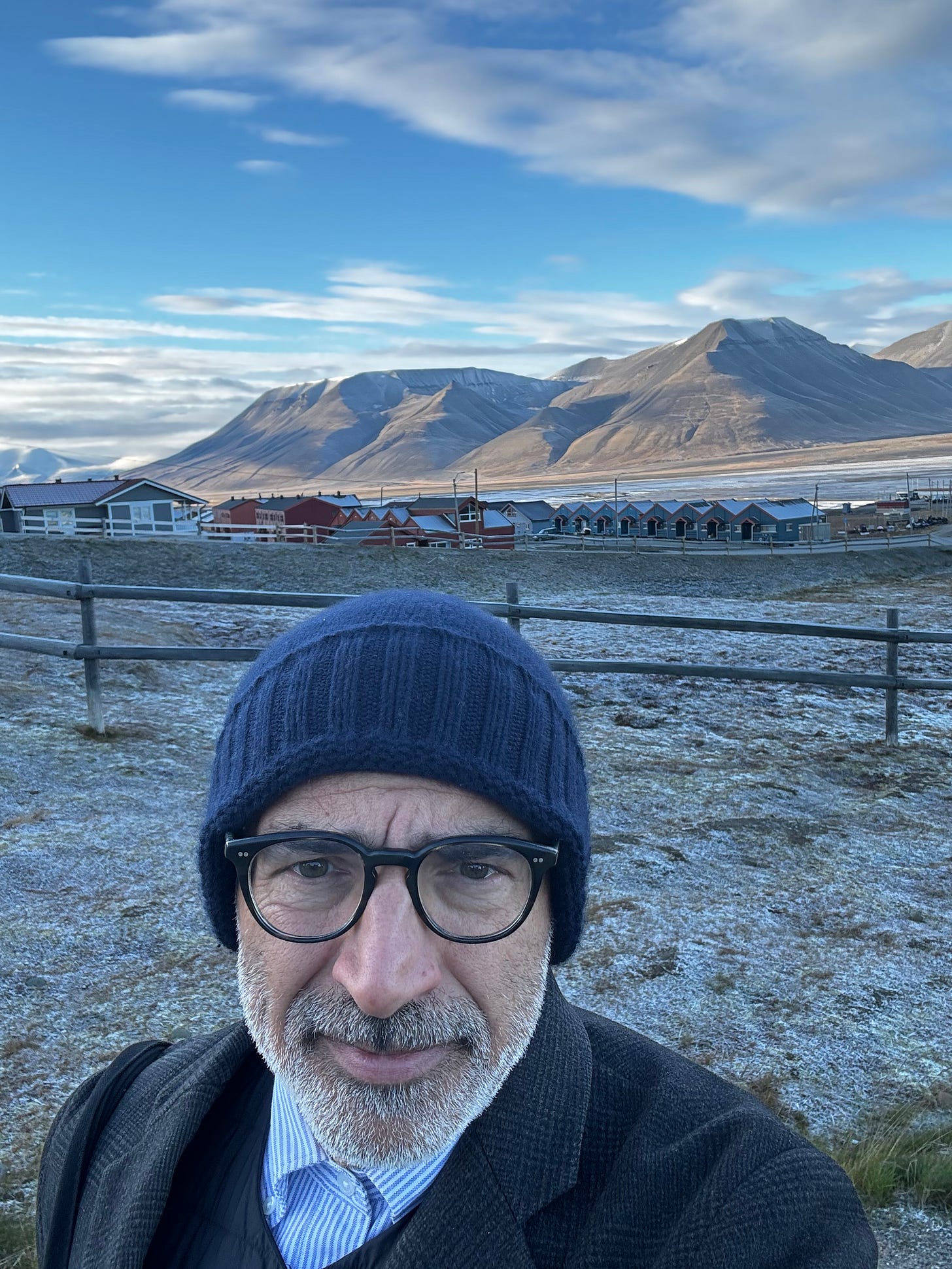At the Svalbard, the archive of masterpieces
In the Arctic archipelago, a mine that should withstand any catastrophe preserves digital copies of important documents. Is it worth the effort to bring them all the way there? We went to check it out
LONGYEARBYEN (Svalbard Islands). Everything here screams "prepare for the worst". Starting with the down jackets for when it's -40 degrees outside, in the store that rents sniper rifles to defend yourself against polar bears (it is strongly recommended to have one with you when you leave the town). But without sacrificing tenderness, since they also sell collapsible plastic flutes for a champagne in the storm. To continue with the Svalbard Museum, which also tells of when the Pomors, diehard Russian immigrants, built shelters on the island to hunt whales all year round and not just during the so-called "nice" season. This year, at the end of September, the climate is still warm, only five degrees below zero, due to global warming that raises temperatures here four times more than the global average. Rune Bjerkestrand is the founder of Piql, specialists in "digital preservation" and also the host; he takes the opportunity to keep a promise made in the program, under the heading "bathing in the Arctic". He puts on his boxers and dives in, followed only by the intrepid archivist of the Jaguar Foundation, an Englishwoman with fuchsia-green-blue hair, perhaps a tribute to the northern lights that we will not be able to see. While the reporter, along with about thirty people who have come from halfway around the world to attend the annual data deposit in the Arctic World Archive (Awa), modestly beat their feet to avoid the necrosis of the big toes. For the ritual of the next day, we will have to go down into a disused mine. It is carved into the permafrost, the perennial ice that guarantees a temperature below zero. Together with other ingredients that we will see, this should ensure that the information physically stored here remains intact for 500 to 2,000 years. The Vatican Libraries, which have a preferential relationship with eternity, have already come here twice to save their copy of the Divine Comedy and much more. But the Mexican and Brazilian governments also came to preserve the manuscripts of their constitutions. One customer - because you pay, although it is difficult to understand how much - is also GitHub, with its immense catalog of free software acquired by Microsoft. And then there's Yale, the European Space Agency, and UNICEF. In short, all smart people who do not throw money away. But really, with all the cloud available, was it necessary to climb to the northernmost inhabited parallel of the globe to be reasonably sure of not losing precious documents? Or is it a misplaced question and the real, ultimate, existential one is that this ascent to the far north has much more to do with reaffirming the sacredness of memory in an ephemeral world like an Instagram story?
IS IT REALLY FOREVER?
Our courtship with Awa began almost a year ago. "We would like to come and see," we wrote. "We go there once a year, ice permitting," they replied. Then, at the right time, they remembered and, at the end of September, along with a BBC crew and two other documentary makers, I find myself here. The night before the actual deposit, the founder Bjerkestrand organizes a press conference at Nordover, one of the two cinemas in the capital of this lunar archipelago of 2,500 humans, 3,000 bears and 15,000 reindeer. Large and dramatic images projected behind him illustrate the "very uncertain times in which we live." From the Isis that has bombarded the Syrian temple of Palmyra to the Taliban who have done the same with the Buddhas of Bamiyan. Up to the devastation in Gaza and the prospect that, in 2050, Venice could end up under water. The subtext is pretty clear: get ready today if you want someone to remember how we were tomorrow. Obviously taking advantage of the special film patented by Piql and tested by the Norwegian Defense Research Institute to last up to two millennia. After him, Christian Clauwers takes the floor. He is a Belgian photographer specialized in documenting the disastrous climatic decline of the planet, who will archive a long work done in the sinking Marshall Islands. In addition to showing unequivocal photos, he mentions that in 2019 the permafrost had melted and there had been an infiltration in mine number 3, the one that houses the Awa and once also housed the prototype of the Seed Vault, the much more famous seed bank that since 2008 has become a kind of ark of planetary biodiversity. No one seems to register this information. We agree to meet again the next day and return, each to their own, to the few hotels in the village, following frozen streams brightened by an unexpected Klein blue sky.
THE "DEPOSIT" RITUAL
Finally, D-day, meaning the day of the deposit. From the hotels we are taken by bus to the most barren hill of my career (a real mystery: how do the reindeer survive?). Three minutes after passing the concrete triangle that marks the fortified entrance to the sperm bank, there is a red metal warehouse, more of a mechanical workshop than Fort Knox, where we recognize some of the staff. The largest delegation is Polish. There are 24 people, five employees and the other wealthy clients of Pekao Bank, the second largest in the country. They came to save 10 important works of art from their heritage. The head of the Chopin Institute also arrives from Warsaw, bringing a number of scores annotated by the Maestro. Then there's Jack Connor, an American from Los Angeles. Despite going around with a skateboard under his arm, he is the president of Lingua Aeterna, an institution that wants to save endangered languages. In the files that he will deliver, there is a large collection of 550 of the most at-risk phrases. For Great Britain there is the aforementioned archivist with a treasure trove of popular iconography linked to the legendary car. Representing France are finds from the work of Serge Bassenko, artist and writer, whose widow has entrusted Awa with 7000 photos she had taken in Venice and 19 novels. With the Belgian jersey, so to speak, the aforementioned Clauwers, who was also his country's official delegate for the UN climate conferences. Finally, the president of DNK, a very powerful Norwegian war risk insurance company. They had also proposed to deposit the first digital copy of Venerdì with us, but in the end, we didn't have the technical time to transform the file into the special film patented by Piql. Because this is what is physically delivered to each depositor, sealed in special aluminum bags. These will be stacked, each behind its own flag, in a container that is 300 meters deep, at the end of a five-minute walk in a dark street of the mine. And there it will remain – we will return to the likelihood of this bet in a moment – for eternity or its human approximation.
OTHER ARCHIVES
A goal that more than one is practicing. Just after booking the plane to Svalbard, news comes out about Southampton researchers who have managed to laser engrave the human genome on a 5D crystal capable of resisting "billions of years". It will be kept in the Hallstatt salt mine in Austria, evocatively named Memory of Mankind (Mom). This project was started in 2012 by the ceramist Martin Kunze who, after reading the apocalyptic book The World Without Us by Alan Weisman, began collecting the most diverse cultural fragments and engraving them on almost indestructible ceramics. This was meant to help the survivors of a possible collapse to rebuild civilization. In fact, albeit from a less millenarian perspective and limited to the humanities, strongholds such as the Harry Ransom Center in Austin, Texas, where I had been a few years ago to consult the David Foster Wallace collection, are still functioning. Namely, his lecture notes, glosses on manuscripts, and boxes and boxes of books. As well as those of Gabriel Garcia Marquez, Don DeLillo, and other literary giants, bought for tens of millions of dollars at a time and made available to future generations. Not to mention The Long Now Foundation, founded by Stewart Brand, the technologist to whom we owe the most famous phrase erroneously attributed to Steve Jobs ("Stay hungry, stay foolish"), whose mission is to encourage long-range debates in an era plagued by ever shorter attention spans. In other words, their followers would like to move from the infamous 8 seconds that we will be able to concentrate before moving on to another post to the 10,000 years that the Long Now Clock should last. Some prototypes of this clock already exist, but its construction in real scale, 150 meters, has been underway for years in the Texan ranch of Jeff Bezos, one of the few with an ego and economic resources suitable for the enterprise. And so we approach the weak point of all these appreciable efforts to recover some chronological perspective in a society that is dramatically crushed into the present. That is: it is easy to say two or ten thousand years, but then who will verify that the promise is kept?
WHAT THE YUCCA MOUNTAIN TEACHES US
In fact, one thing that came to mind as I went with a helmet and a speleologist light into the bowels of Gruve 3, the Awa mine 3, is a good book called A Mountain. Where the author John D'Agata, who went to help his mother move to Las Vegas, becomes passionate about the story of Yucca Mountain where the government would like to store nuclear waste for "10,000 years". But where does that round number come from, D'Agata wonders? By investigating, he discovers that to be truly safe, the waste should be stored for millions of years and that the panel of experts had suggested the 10,000-year figure to the Department of Energy only because it was more convincing. Not to mention the imponderable structural safety of the site, including the risk of earthquakes or infiltration. And the fact that human beings in ten thousand years will be able to decrypt the safety warnings, because they may no longer speak our language. In other words, if for a brief moment even De Beers had revised its iconic slogan "a diamond is forever" to "forever, now", well then it means that you have to be very careful with the claim to extend towards infinity.
But doubt is not the best profile of Rune Bjerkestrand, Mr. Piql. After the lively press conference, the ceremony of the deposit and a spectacular dinner in a restaurant specializing in reindeer, I finally get to interview him. I start with the most prosaic question: how much does it cost to store documents? "We don't say because it varies a lot, it depends on how many materials and for how long." A rough estimate? "I could say from 10 euros to 1 million euros, but it wouldn't make sense. If you really want to know, ask for a quote on the site." Which we did, only to discover that saving the first copy of Friday from here to eternity would cost us 139 euros. I then mention the competition, those of the crystal that lasts "billions of years": "How did they test them? Our 500-2000 years are certified by a highly respected public body." But in case of permafrost infiltration, as Clauwers said? "It happened there because the first Seed Vault site was in the wrong part of the mine, a part where water can reach. We, on the other hand, are in an area where, even if there were liquids, the slope would take them elsewhere."
THE SUSCEPTIBLE FOUNDER
The most macroscopic black hole, for me, concerns security. It is true, as you said in the talk the day before, that Svalbard is a demilitarized zone where everyone leaves their bikes open, without a lock, because a thief would be caught the same day, but if an attacker comes from outside with a pair of wire cutters or a hacksaw, he can saw the lock of the mine and reach the sancta sanctorum without encountering great resistance. Now he looks at me badly: "But this doesn't make sense because the type of file we safeguard doesn't contain industrial secrets: only culturally significant fragments. And in any case, for every physical film, detached from the network and therefore not hackable or modifiable, we have a copy in a safe location and multiple digital copies in as many servers.» But then we're back to square one: why should it be safer to bring a physical copy here instead of saving a hundred digital copies on as many servers around the world? It is statistically impossible that I am the first journalist to raise such an objection: "Our technology, in which we have invested 45 million in research and development, is extremely robust. The film saves information in two ways: with high-density QR codes that refer to digital documents and with pictograms that reproduce the actual works. In the distant future, a light source and a camera will be enough to consult them. Not only that: we have provided a "virtual machine" on the film that will allow documents to be read without the need for any other technology. No server can provide you with comparable security, not even remotely." Despite impeccable credentials (their partner is in fact the Norwegian Ministry of Industry that owns the island's mines) and noble customers, his Norwegian inflexibility does not help the cause. The film can withstand chemical or bacteriological warfare, but a fire can put it in crisis. In The Mountain, D'Agata thoroughly questions the human ambition of control. Which clashes with a list of predictions of possible ends of the world. At one point he also quotes Edvard Munch and his The Scream as a metaphor for collective anxieties about the future. It is useful to have, he writes, to avoid self-destructive behavior. A painting, moreover, whose digital copy the Museum of Contemporary Art in Oslo has already saved for years on Awa film. Whether or not it lasts as long as it says it will, the storage in mine number 3 will certainly increase its chances of reaching posterity. And this, net of the hubris of men, is certainly a good and right thing for our idea of civilization.
(from il Venerdì di Repubblica, automatic translation by Lara/Translated)





